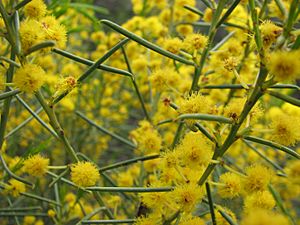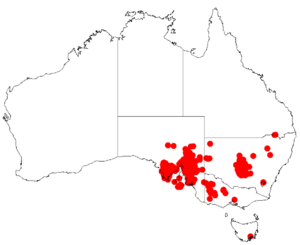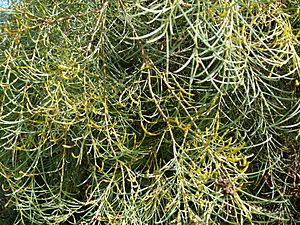Wallowa facts for kids
Quick facts for kids Wallowa |
|
|---|---|
 |
|
| A. calamifolia inflorescences | |
| Scientific classification | |
| Genus: |
Acacia
|
| Species: |
calamifolia
|
 |
|
| Occurrence data from AVH | |
The Acacia calamifolia, also known as wallowa or reed-leaf wattle, is a type of shrub or tree. It belongs to the Acacia family. This plant grows naturally only in the southeastern parts of Australia.
Contents
What Does the Wallowa Plant Look Like?
The wallowa plant is usually a round-shaped shrub. It typically grows to be about 2 to 4 metres (7 to 13 ft) tall. Some can even reach up to 10 m (33 ft)! The plant is also usually 2 to 4 m (6 ft 7 in to 13 ft 1 in) wide.
Leaves and Flowers
Its leaves are called phyllodes. They are long and thin, like reeds, and are green to grey-green. These phyllodes are 2 to 10.5 cm (0.79 to 4.13 in) long and only about 1 to 1.5 mm (0.039 to 0.059 in) wide. They have a slightly curved tip and feel smooth.
The wallowa blooms with yellow flowers between October and November. These flowers grow in groups called inflorescences. Each group has two to eight flower heads. The flower heads are round or oval-shaped and contain 28 to 46 golden-yellow flowers.
Seeds and Pods
After the flowers, the plant grows woody seed pods. These pods look like a string of beads and can be up to 15 cm (5.9 in) long. They are 3 to 6 mm (0.12 to 0.24 in) wide. Inside the pods are dull, dark brown to black seeds. Each seed is about 6 to 9 mm (0.24 to 0.35 in) long.
How Was the Wallowa Named?
The Acacia calamifolia was first officially described in 1824. A botanist named Robert Sweet wrote about it in a book by John Lindley.
Meaning of the Name
The scientific name calamifolia comes from two Latin words. Calamus means reed, and folium means leaf. This name describes the plant's long, thin leaves, which look like reeds.
Where Does the Wallowa Grow?
This shrub is found in several parts of Australia. You can see it in South Australia, from the Flinders Ranges down to the northern Mount Lofty Ranges. It also grows east towards Broken Hill in New South Wales and in northwestern Victoria.
The wallowa often grows in woodlands and open scrubland areas. It can grow in many different types of soil.
How Can You Grow Wallowa Plants?
People often plant the wallowa as a medium-sized ornamental plant. It can also be used as a low shelter plant in gardens.
Growing Conditions
This plant can handle full sun or partial shade. It prefers soil that drains water well, but it can also survive short periods of being waterlogged. The wallowa is tough! It can handle dry weather and even frost down to −7 °C (19 °F).
Benefits for Wildlife
The wallowa plant provides a good home for birds. Its seeds are also an important food source for the Malleefowl, a type of bird found in Australia.


